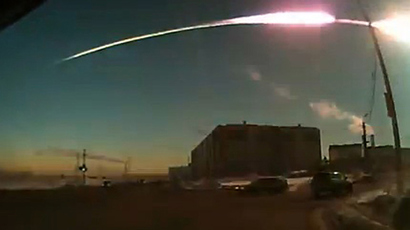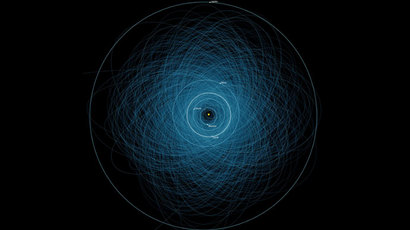Astronomers discover 'Trojan asteroid' in Uranus' orbit

The seventh planet from the sun was once considered too distant to host asteroids, but that concept was blown away with the discovery of a new triangle in the sky – its points being the sun, the Uranus and a 36-mile-wide body of rock and ice in its orbit.
Researchers at the University of British Columbia (UBC) said they
believe the Trojan asteroid, which has been given the official
tag 2011 QF99, belongs to a larger-than-anticipated number of
transitory objects of the kind presently trapped by the
gravitational pull of the Solar System's larger planets.
The astronomers presented their findings in the Aug. 30 issue of
the journal Science.
Trojan asteroids are objects that share their orbit with a
planet, but do not collide with it. The sun, Uranus and the newly
discovered asteroid form a triangle whose sides are currently
about 1.7 billion miles (2.8 billion km) long.
Astronomers had considered Trojans at Uranus a low possibility
since the gravitational pull of larger neighboring planets would
eventually eject any Trojan asteroids that may be circling the
planet’s gravitational field.
"Our model predicts that at any given time three per cent of
scattered objects between Jupiter and Neptune should be
co-orbitals of Uranus or Neptune," lead study author Mike
Alexandersen told UPI.

This percentage surprised the researchers as it is much higher
than previous estimates, says a UBC press release.
In 2011 and 2012, astronomers were tracking objects in the
vicinities of the giant planets for 17 months in order to better
understand the evolution of the outer solar system.
"Our search was focused on finding Neptunian Trojans and
trans-Neptunian objects," study lead author Mike
Alexandersen, an astronomer at the University of British Columbia
in Vancouver, told SPACE.com. "One is always surprised and
excited to find something other than what one was expecting and
searching for."
QF99 ranks as a ‘temporary’ Trojan, according to the Canadian
astronomers, because the object was only recently (within the
last few hundred thousand years) captured by Uranus. The asteroid
is predicted to escape the planet's orbit in about a million
years.
"This tells us something about the current evolution of the
Solar System," Alexandersen said. "By studying the process
by which Trojans become temporarily captured, one can better
understand how objects migrate into the planetary region of the
Solar System."
Asteroid QF99 is about 19 astronomical units from the sun — that
is, 19 times that between the Earth and sun. The Earth is
typically about 93 million miles (150 million kilometers) from
the sun.















